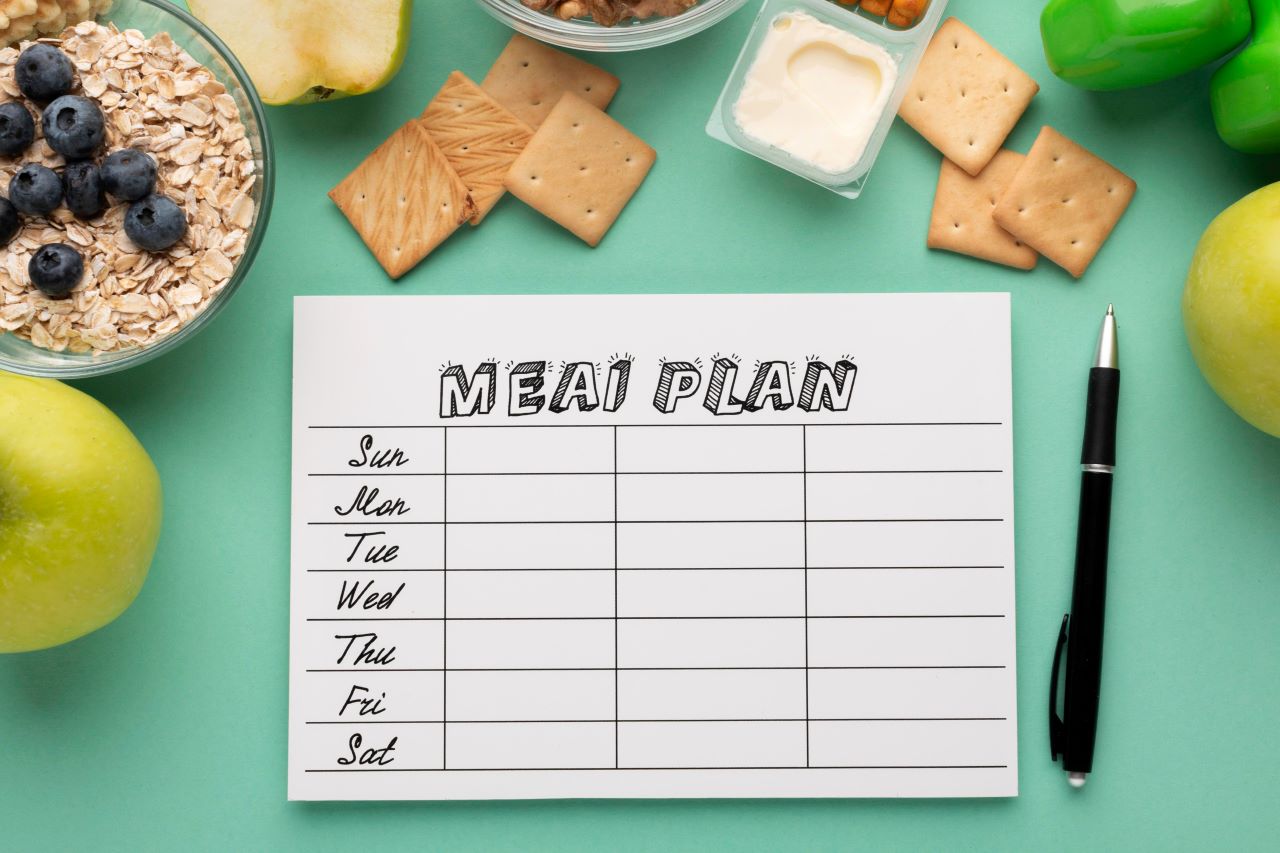Balancing a healthy diet with a tight budget is a common struggle for many. When money is tight, choosing nutrient-packed foods over cheaper, less healthy options is tough. However, the significance of good nutrition for our overall well-being must be addressed. This challenge affects individuals and families alike, making it crucial to find practical ways to eat well without spending a fortune. This article will explore simple and affordable tips for a balanced diet on a budget to help everyone overcome financial hurdles.
Eating a balanced diet isn’t just a health fad; it’s a necessity. The nutrients in our food are like the fuel our bodies need to function correctly, stay strong, and ward off illnesses. Unfortunately, the cost of nutritious foods often puts them out of reach for those on a budget. From clever grocery shopping to budget-friendly recipes, we’ll guide you through practical steps to achieve a balanced diet without breaking the bank.
Understanding a Balanced Diet:
Eating well is not just filling your stomach; it’s about giving your body the right nutrients to function at its best. A balanced diet is like a team of superheroes, with each nutrient playing a unique role. Let’s dive into the dynamic world of nutrition:
Proteins: The Builders
Proteins are the construction workers of your body, diligently building and repairing tissues. Whether it’s repairing a muscle after a workout or supporting the growth of new cells, proteins are the unsung heroes. Diverse sources like lean meats, eggs, and plant-based options like beans ensure a protein-packed team ready for action.
Carbohydrates: The Energizers
Carbs are the energy boosters powering you through your day. Think of them as the fuel for your body’s engine. From the complex carbs found in whole grains, giving you a steady release of energy, to the quick pick-me-up from fruits, carbohydrates are your body’s preferred energy source.
Fats: The Brainiacs
Fats are the brainiacs, supporting brain health and keeping things running smoothly. They’re like the architects, ensuring the efficient communication of signals within the nervous system. Healthy fats from avocados, nuts, and olive oil contribute to a well-functioning brain and a happy, healthy body.
Vitamins: The Boosters
Vitamins are the boosters that enhance various bodily functions. They play diverse roles, from boosting your immune system (vitamin C) to aiding in bone health (vitamin D). Like a team of specialized agents, each vitamin brings something unique to the table, found abundantly in colorful fruits and vegetables.
Minerals: The Regulators
Minerals are the regulators, ensuring everything runs smoothly. From bone-strengthening calcium to iron, a crucial component in oxygen transport, minerals maintain balance in the body. A mix of dairy, nuts, and leafy greens provides a symphony of minerals for overall well-being.
Understanding these superheroes and their roles in your body empowers you to make informed choices. A balanced diet is not a rigid formula but a dynamic dance of nutrients that cater to your body’s unique needs.
The Impact of Budget Constraints on Diet:
Budget constraints often act as formidable barriers, influencing our food choices in ways that can compromise overall health. When money is tight, individuals and families may find themselves relying on cheap, processed foods that are high in calories but low in essential nutrients. This shift not only impacts physical well-being but also increases the risk of various health issues.
The Challenge of Processed Foods:
One of the primary challenges imposed by budget constraints is the reliance on processed foods. These often come in the form of convenient, pre-packaged meals or fast food options, which are frequently more affordable than fresh, whole foods. However, these processed alternatives are often laden with unhealthy additives, preservatives, and high levels of salt and sugar, contributing to a less-than-ideal nutritional profile.
Nutrient Deficiency and Health Risks:
A diet dominated by processed, nutrient-poor options can lead to nutrient deficiencies. When essential vitamins and minerals are lacking, the body struggles to perform basic functions, leaving individuals vulnerable to a range of health risks. These risks may include weakened immune systems, impaired cognitive function, and an increased likelihood of chronic diseases.
Weight Management Challenges:
Beyond the immediate health impacts, budget-influenced diets can also contribute to weight management challenges. Processed foods, while often high in calories, may lack the satiating effect of nutrient-dense options. As a result, individuals may find themselves consuming more calories in an attempt to satisfy hunger, potentially leading to weight gain and associated health issues.
Long-Term Consequences:
The repercussions of budget-influenced dietary choices extend beyond the short term. Chronic health issues arising from poor nutrition can lead to increased healthcare costs and a lower quality of life. The long-term consequences underscore the importance of finding sustainable, budget-friendly approaches to maintaining a balanced diet.
Practical Tips for Eating Well on a Budget:
Navigating the terrain of a balanced diet on a budget requires strategic and practical approaches. Let’s break down actionable tips to make this journey not only health-conscious but also pocket-friendly.
1. Smart Shopping Strategies:
Buying in Bulk:
When possible, opt for bulk purchases. Warehouse or bulk stores often offer discounts for buying larger quantities. Essentials like rice, pasta, and legumes are excellent choices for bulk buying, as they have a long shelf life.
Sales and Discounts:
Keep an eye on sales and discounts. Plan your grocery shopping around weekly promotions and discounted items. This allows you to save money without compromising on the nutritional value of your purchases.
Choosing Cost-Effective Yet Nutritious Options:
Look for budget-friendly alternatives that still pack a nutritional punch. For instance, opt for frozen vegetables and fruits when fresh ones are expensive or out of season. Canned beans and legumes are convenient, affordable, and rich in protein.
2. Meal Planning and Batch Cooking:
Benefits of Meal Planning:
Meal planning is a game-changer. By outlining your meals for the week, you can create a shopping list that ensures you only buy what you need. This reduces the likelihood of impulsive and costly purchases.
Batch Cooking for Efficiency:
Batch cooking is a time-saving superhero. Prepare larger quantities of meals and freeze portions for later. This not only saves time on hectic weekdays but also prevents the need for frequent, potentially costly, takeout meals.
Practical Tips for Planning:
- Choose versatile ingredients used in multiple meals.
- Plan meals that share common ingredients to minimize waste.
- Rotate your weekly menu to keep things interesting without breaking the bank.
3. Choosing Affordable Nutrient-Dense Foods:
Staple Foods for a Budget-Friendly Diet:
- Fruits: Opt for seasonal fruits and those on sale. Apples, bananas, and oranges are often cost-effective and rich in essential nutrients.
- Vegetables: Frozen vegetables are budget-friendly and retain their nutritional value. Leafy greens like spinach and kale are nutrient-dense choices.
- Whole Grains: Brown rice, oats, and whole wheat pasta provide fiber and essential nutrients at an affordable price.
- Lean Proteins: Eggs, canned tuna, and chicken thighs are economical protein sources.
A balanced diet means getting the right mix of nutrients your body needs. Think of it as giving your body a variety of foods to stay healthy and energized. Here’s a breakdown:
| Nutrient | What it does | Good Sources |
| Proteins | Builds muscles and repairs cells | Eggs, beans, chicken |
| Carbs | Main energy source | Whole grains, fruits, veggies |
| Fats | Supports brain health | Avocado, nuts, olive oil |
| Vitamins | Boosts various body functions | Fruits, vegetables, sunlight |
| Minerals | Strengthens bones and teeth | Dairy, nuts, leafy greens |
Understanding these nutrients helps in making informed choices when planning meals.
4. Minimizing Food Waste:
Proper Storage:
Store perishables properly to extend their lifespan. Keep fruits and vegetables in the refrigerator, store grains in airtight containers, and freeze items that won’t be used immediately.
Creative Use of Leftovers:
Transform leftovers into new meals. For example, yesterday’s roasted vegetables can become a delicious omelet or a topping for a grain bowl. Be imaginative and experiment with flavors.
Repurposing Ingredients:
Choose versatile ingredients that can serve multiple purposes. For instance, a whole chicken can be used for a roast dinner one night and transformed into sandwiches or wraps for lunches.
Budget-Friendly Recipes:
Now, let’s put these tips into action with a few budget-friendly recipes that are not only nutritious but also easy on the wallet.
Vegetarian Chickpea Stir-Fry:
- Ingredients: Canned chickpeas, frozen mixed vegetables, soy sauce, garlic, and ginger.
- Cost-Effective Twist: Replace fresh vegetables with frozen ones and use canned chickpeas for an affordable yet protein-packed stir-fry.
- Instructions:
- Sauté garlic and ginger in a pan.
- Add mixed vegetables and canned chickpeas.
- Stir in soy sauce.
- Serve over brown rice.
One-Pot Lentil Soup:
- Ingredients: Dried lentils, carrots, celery, onion, vegetable broth, and spices.
- Cost-Effective Twist: Dried lentils are economical and a great source of protein.
- Instructions:
- Sauté onions, carrots, and celery in a pot.
- Add dried lentils, vegetable broth, and spices.
- Simmer until lentils are tender.
- Enjoy a hearty and budget-friendly soup.
These recipes showcase how affordable ingredients can be transformed into delicious and nutritious meals. By incorporating these practical tips and recipes into your lifestyle, achieving a balanced diet on a budget becomes not just a goal but an accessible reality.
Disclaimer:
These recipes are provided for informational purposes only. Individual dietary needs may vary, and it is important to consult with a healthcare professional or a registered dietitian to ensure that these recipes align with personal health goals and dietary requirements. The cost-effectiveness of ingredients may also depend on location and availability. Additionally, those with allergies or specific dietary restrictions should carefully review the ingredient list and make appropriate substitutions.
Conclusion:
Practical strategies like intelligent shopping, meal planning, and choosing affordable yet nutrient-dense foods prove essential in the journey toward a balanced diet on a budget. These approaches and creative ways to minimize food waste empower individuals to prioritize health without overspending. The included budget-friendly recipes highlight that a nutritious diet is accessible and feasible for everyone. Essentially, it’s about making mindful choices that nourish our bodies and wallets simultaneously.











